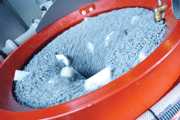E-Archive
Good Vibrations
in Vol. 9 - July Issue - Year 2008
Slide Grinding – A New Term For A Mass Finishing Technology?

Picture 1: slide grinding is a process copied from nature: a controlled form of erosion with stones and water

Pic 2: application parts and plastic media

Pic. 3: centrifugal slide grinding: effective and clean

Pic. 4: modern PLC control panel
It is interesting that the fundamental industrial technology of mass finishing technology does not even have an exact English term in common usage that accurately describes that kind of technology. Mass finishing could actually describe something other than treating work pieces in vibratory bowls with abrasive media. And the term vibratory finishing does not include the processes of barrel tumbling and centrifugal finishing.
In Germany, there is such a term. "Gleitschleifen" – literally translates to slide grinding – which includes the process technology of all types of vibratory, centrifugal and tumbling finishing.
Slide grinding versus mass finishing
In Germany, the technicians have adopted the precise term of "Gleitschleifen", but this terminology is not well known worldwide, and is not widely used, even in academic circles with focus on metals. Taking a look into literature, magazines, online articles, study programs of professional and engineering schools, you will find that slide grinding is seldom mentioned. It’s surprising, and Dirk Gather hits the mark very well in his last MFN article: “…all around the world and in nearly every metal production branch surface finishing solutions are essential parts of the value added chain.” His statement, that qualified surface finishing people are hard to find, is typical for the lack of public common knowledge of surface finishing, or more specifically, slide grinding.
The Vague Perception of Slide Grinding
One attempt to explain the reason may be that slide grinding is usually a peripheral process. When mass parts are designed on CAD, you will normally not see the surface quality and the burrs at first sight. In the early stage of part-development other things like the mere construction and production possibilities of the often die-cast, sawn or stamped parts may be of greater importance. A burr is not visible on a blueprint drawing of a solid.
The deburring process is often seen as a burdensome operation which unfortunately has to be executed after the “normal” production and the shaping of the solid, adding additional unforeseen costs to the manufacturing process. But this is an attitude which is not fair to slide grinding. Many people do not know that slide grinding can much more than deburr or polish parts. In fact, it can add certain beneficial properties to workpieces, which can improve their total quality. It can, for example:
-influence the roughness of surfaces
-enhance the lifetime of parts or the products the parts come in touch with
-improve the corrosion resistance of materials
-enhance the visual appearance
-upgrade the glide property of parts in movement and therefore their function
-clean parts to meet specific quality
-descale parts
-smooth parts
-edge-break parts
Considering these application fields of slide grinding, you will find out that it is not just an additional cost factor in the production of metal and plastic parts, but that it can add value in nearly every fabrication.
Complex Surface Effects Need Complex Technology
The technology of slide grinding does not consist of a simple tub with stones in it. When you consider a work piece of a special material and a given shape with complex geometry, there will be no way of calculating and predicting a certain process which will guarantee treatment success. It needs the judgement of an experienced surface finishing technician and often a series of trials to find the best solution. This solution consists not only of the right machine and its tuning parameters, but especially of water quality and quantity, the chip geometry, material and quality, the right compound for the surface effect and other additives which may be necessary for the whole process. That so-called process recipe is not easy to find and sometimes the right recipe is as valuable as the finishing machine itself.
Furthermore, the technique of process water recycling and circulation is a related technology, with which many slide grinding beginners have no experience. Initially, capital investment in recycling may be higher but there is money saving potential, as the necessary water and compound can be reused and continuously recycled, which is a benefit for the environment.
A False Prejudice?
A common misconception of slide grinding is the opinion that this kind of mass finishing is rough and inexact, dirty, clumsy and loud and that the process is hard to control. Many people think of a large round bowl tub with a couple of switches for ON/OFF and STRONG/WEAK Mode. In reality the new slide grinding installations are equipped with very sophisticated PLC-controls. And the trend goes even further, so that actually we see the need to combine PC and databases to larger installations. So slide grinding installations can be fully integrated into the company-LAN via Ethernet. The PLC of the electrical control unit is connected to a Network-PC by Ethernet. Then a database client on that PC can transmit the vital process parameters, including actual operating mode, quantity of treated parts, process recipe, and error history etc. to a central database on the company’s server. Especially when a company is confronted with demands for international standards like DIN ISO 9001 and TS 16949, these technical possibilities add much value. The production records which have been produced are documented for years in a central database, and offer an accurate manufacturing history record for legal requirements as well as for the strict regulations of the automotive sector.
As we can see, some “good vibration” thoughts about the technology and understanding of slide grinding as a modern and fully developed technology are not only overdue, but very appropriate for today’s demands.
Tel. +49.2871 9500 14
Spaleck Oberflächentechnik GmbH & Co. KG



























